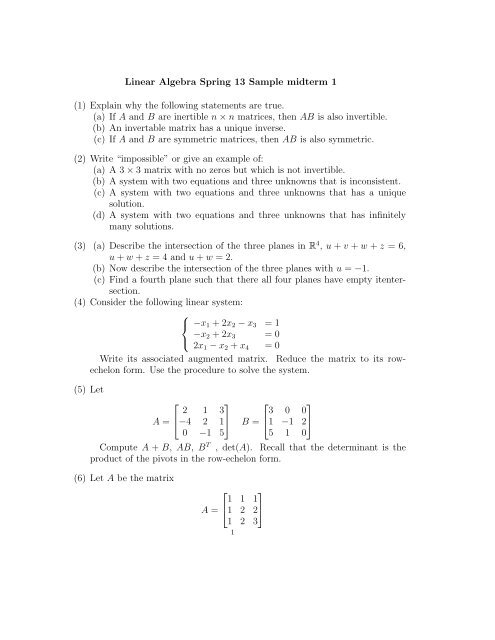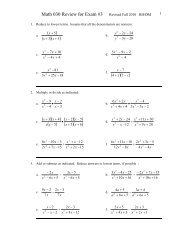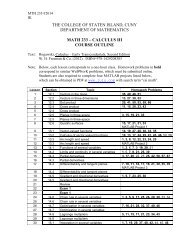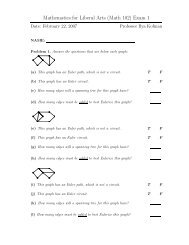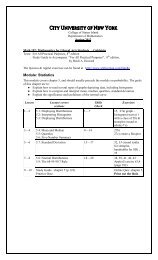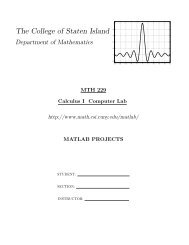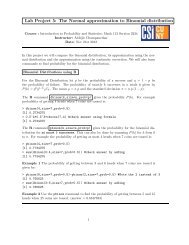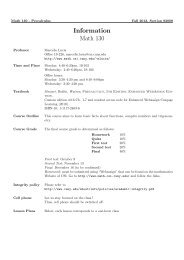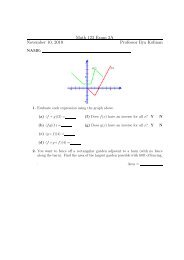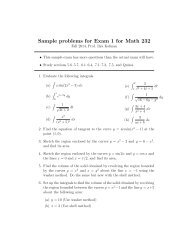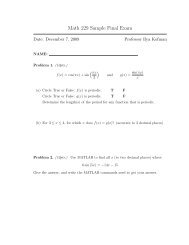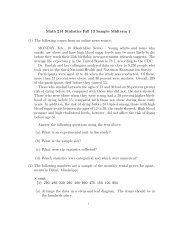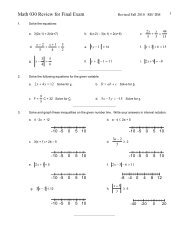Linear Algebra Spring 13 Sample midterm 1 (1) Explain why the ...
Linear Algebra Spring 13 Sample midterm 1 (1) Explain why the ...
Linear Algebra Spring 13 Sample midterm 1 (1) Explain why the ...
You also want an ePaper? Increase the reach of your titles
YUMPU automatically turns print PDFs into web optimized ePapers that Google loves.
<strong>Linear</strong> <strong>Algebra</strong> <strong>Spring</strong> <strong>13</strong> <strong>Sample</strong> <strong>midterm</strong> 1(1) <strong>Explain</strong> <strong>why</strong> <strong>the</strong> following statements are true.(a) If A and B are inertible n × n matrices, <strong>the</strong>n AB is also invertible.(b) An invertable matrix has a unique inverse.(c) If A and B are symmetric matrices, <strong>the</strong>n AB is also symmetric.(2) Write “impossible” or give an example of:(a) A 3 × 3 matrix with no zeros but which is not invertible.(b) A system with two equations and three unknowns that is inconsistent.(c) A system with two equations and three unknowns that has a uniquesolution.(d) A system with two equations and three unknowns that has infinitelymany solutions.(3) (a) Describe <strong>the</strong> intersection of <strong>the</strong> three planes in R 4 , u + v + w + z = 6,u + w + z = 4 and u + w = 2.(b) Now describe <strong>the</strong> intersection of <strong>the</strong> three planes with u = −1.(c) Find a fourth plane such that <strong>the</strong>re all four planes have empty itentersection.(4) Consider <strong>the</strong> following linear system:⎧⎨⎩−x 1 + 2x 2 − x 3 = 1−x 2 + 2x 3 = 02x 1 − x 2 + x 4 = 0Write its associated augmented matrix. Reduce <strong>the</strong> matrix to its rowechelonform. Use <strong>the</strong> procedure to solve <strong>the</strong> system.(5) Let⎡A = ⎣ 2 1 3⎤ ⎡−4 2 1⎦ B = ⎣ 3 0 0⎤1 −1 2⎦0 −1 5 5 1 0Compute A + B, AB, B T , det(A). Recall that <strong>the</strong> determinant is <strong>the</strong>product of <strong>the</strong> pivots in <strong>the</strong> row-echelon form.(6) Let A be <strong>the</strong> matrix⎡A = ⎣ 1 1 1⎤1 2 2⎦1 2 31
2Find <strong>the</strong> LU factorization of A by writing down <strong>the</strong> elementary matricesfor <strong>the</strong> row operations, and multiplying <strong>the</strong>m toge<strong>the</strong>r.(7) Let A be <strong>the</strong> matrix⎡A = ⎣ 1 0 1 0⎤0 2 1 1 ⎦1 −1 1 −1(a) Write down a matrix that swaps <strong>the</strong> first and second rows of A, and addstwice <strong>the</strong> first row to <strong>the</strong> third row. Show this works by writing out <strong>the</strong>matrix multiplication.(b) Write down a matrix that swaps <strong>the</strong> first and last columns of A and addsthree times <strong>the</strong> second row to <strong>the</strong> third row. Show this works by writingout <strong>the</strong> matrix multiplication.(8) Use row operations to find <strong>the</strong> inverse of:⎡A = ⎣ −1 0 0⎤−2 0 1 ⎦3 1 −2(9) Find examples of 2 × 2 matrices such that(a) A 2 = −I(b) A 2 = 0, with A ≠ 0(c) CD = −DC ≠ 0(d) EF = 0, though no entries of E or F are zero.(10) Are <strong>the</strong> following vectors linearly independent?(a) { [1, 2, 3], [0,0,0], [-1, 2, 0] }(b) { [1, 2, 3], [-1, 0, 1], [2, 4, 1] }


